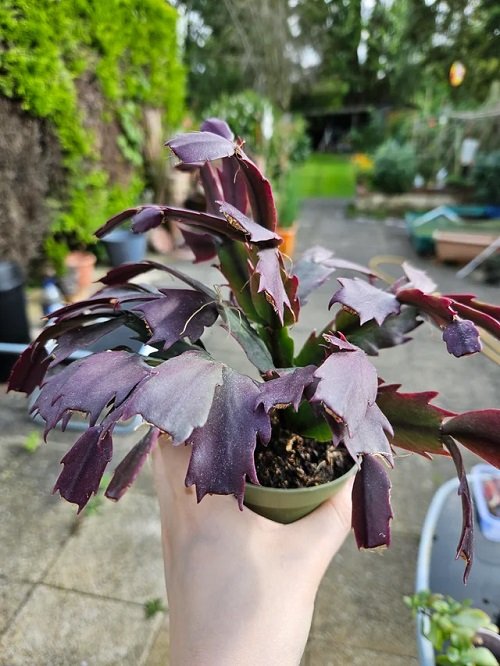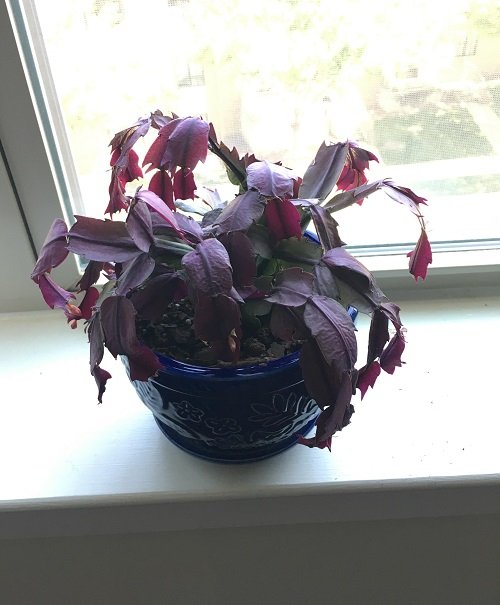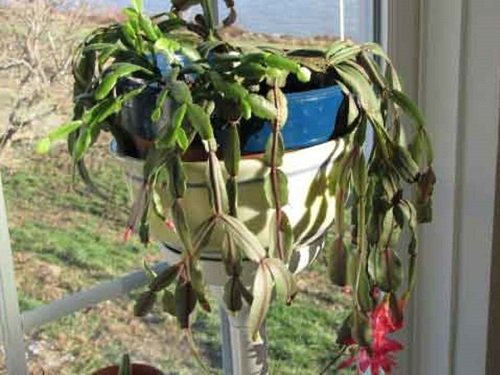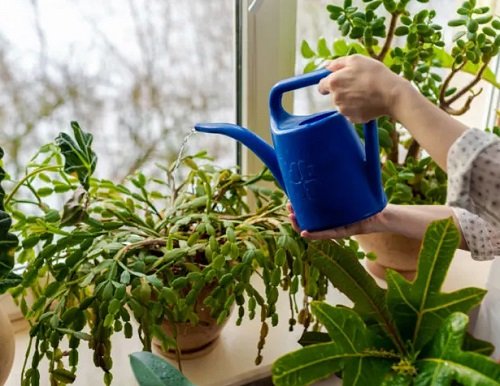Wondering about Christmas Cactus Turning Purple? Here are the Reasons and Solutions why this might be happening.
If you’re looking for an answer to your question–Why Is My Christmas Cactus Turning Purple? You’ve landed on the right post! Read on to uncover the reasons causing this purple coloration and solutions so you can maintain a healthy plant.
Orchid Leaves Splitting | 4 Major Reasons and Solutions
Is it Common for My Christmas Cactus Turning Purple?

While Christmas cacti are known for their striking and varied hues, the emergence of purple tones in their leaves is often a sign of underlying stress or imbalance. While occasional changes in color can occur due to environmental shifts, such as temperature fluctuations or changes in light exposure, persistent or widespread purple discoloration is not considered normal.
It’s crucial to investigate the potential causes behind this color change to ensure the health and vitality of your plant. If you’ve been looking for the answer to “Why Is My Christmas Cactus Turning Purple?”, here it is.
Why Is My Christmas Cactus Turning Purple? Reasons and Solutions
1. Temperature Stress
Christmas cacti, belonging to the tropical cactus family, are finicky about temperature changes. They thrive within a specific temperature range and can respond dramatically to fluctuations.
One significant trigger for the development of purple discoloration on the leaves is temperature stress. This stress often arises from high temperatures, exposure to cold drafts, or rapid shifts in temperature, particularly when the cactus is in its flowering phase.
Solution
To prevent the occurrence of purple leaves due to temperature stress, it’s crucial to create a stable and favorable environment for your Christmas cactus. Here’s how:
- Avoid Cold Drafts: Keep your cactus away from areas prone to drafts, such as near windows, doors, or vents. These are common sources of abrupt temperature changes.
- Maintain Consistent Temperatures: Aim to maintain a relatively steady temperature range around your Christmas cactus. Fluctuations between day and night temperatures should be minimal.
- Monitoring During Flowering: Pay extra attention to temperature control while the cactus is flowering. Provide a cozy and sheltered spot to shield it from sudden temperature shifts.
- Humidity Regulation: Adequate humidity can also play a role in minimizing temperature stress. Increasing humidity levels around the cactus can buffer against rapid temperature changes.
2. Too Much Sun
Sunlight plays a vital role in the health and appearance of your Christmas cactus. While these cacti thrive in certain light conditions, excessive exposure to direct sunlight can have adverse effects, potentially resulting in undesirable leaf discoloration, including a purple tint. Ever thought, “Why Is My Christmas Cactus Turning Purple?” this might be it.
When grown indoors or in outdoor settings with partial shade, they maintain their optimal color and health. However, subjecting the cactus to intense, direct sunlight all day can disrupt this delicate balance.
Solution
Achieving the right balance between light exposure and protection is essential for maintaining the health and appearance of your Christmas cactus:
- Indoor Placement: Place your cactus near a window with filtered or dappled sunlight, especially if the direction is south. Avoid windows with intense, direct sun exposure, especially during midday.
- Outdoor Care: If you’re cultivating your Christmas cactus outdoors, choose a location that offers partial shade or morning sunlight. Shield the cactus from the scorching afternoon sun.
- Use Sheer Curtains or Shade Cloth: If your cactus is indoors, you can use sheer curtains or shade cloth to diffuse the sunlight and prevent direct exposure.
- Rotate the Plant: Regularly rotate the cactus to ensure even light distribution and prevent one side from getting too much sun.
Keep a close watch on your Christmas cactus’s response to light. If you notice any signs of stress, such as purple discoloration or wilting, it’s crucial to adjust its light exposure promptly.
3. Nutrient Deficiency, Overfertilization, or Mineral Imbalance

The nutritional well-being of your Christmas cactus significantly influences its appearance and health. Both inadequate and excessive fertilizer levels can lead to variations in coloration, and a specific nutrient deficiency, phosphorus, is known to cause the development of purple foliage.
As shown in the image, hard water can also be responsible for spots on the foliage and the overall ill-being of the leaves.
The Importance of Phosphorus
Phosphorus is a vital nutrient that plays a pivotal role in various plant functions, including energy production, cell division, and synthesizing compounds crucial for healthy growth and vibrant coloration. When your Christmas cactus lacks sufficient phosphorus, it struggles to maintain its characteristic green color, leading to the emergence of a purple hue.
Solution
To counteract nutrient imbalances and prevent the onset of purple foliage, follow these guidelines for effective fertilization:
- Choose the Right Fertilizer: Opt for a water-soluble fertilizer specifically formulated for cacti or apply a balanced feed. These fertilizers typically contain balanced ratios of essential nutrients, including phosphorus.
- Feeding Frequency: During the active growing season, which typically spans from spring through early fall, feed your Christmas cactus every 2 weeks in a weak one-quarter dose of the recommended strength. This schedule provides a steady supply of nutrients without overwhelming the plant.
- Phosphorus Inclusion: Ensure that the chosen fertilizer contains an appropriate amount of phosphorus. This nutrient should be present to support healthy coloration and overall plant well-being.
- Moderation is Key: Avoid overfeeding your Christmas cactus, as excessive nutrients can be detrimental; this is why low strength is helpful. Overfeeding can lead to nutrient imbalances, potentially exacerbating the purple foliage issue.
- Use Non-Chlorinated Soft Water: Nonchlorinated water is the best way to keep the foliage clean and the plant free of issues.
4. You’re Not Watering it Right
Proper watering is a cornerstone of Christmas cactus care. Both overwatering and underwatering can contribute to stress and the development of purple leaves. To maintain optimal health and coloration, it’s essential to adhere to the right watering practices.
The Dangers of Improper Watering
- Overwatering: Drowning your Christmas cactus in excess water can lead to root suffocation and reduced oxygen availability. As a result, the plant’s ability to absorb nutrients becomes compromised, causing leaves to display purple patches.
- Underwatering: Insufficient water application prevents the cactus from accessing essential nutrients, including phosphorus. This deficiency can manifest as purple foliage as the plant redirects resources to cope with the stress.
Solution
- Well-Draining Potting Mix: Use a well-draining potting mix to prevent waterlogging and ensure proper oxygen circulation to the roots.
- Check Soil Moisture: Water your Christmas cactus when the top inch of soil feels dry to the touch. Insert your finger to assess the moisture level before deciding to water.
- Thorough Watering: When watering, ensure that water evenly saturates the soil. Allow excess water to escape through drainage holes, preventing water from pooling at the bottom of the pot.
- Water Removal: After about 30 minutes, discard any excess water that has accumulated in the saucer or tray beneath the pot. This prevents the roots from sitting in standing water.
How To Water Plants + 5 Watering Mistakes You’re Doing
5. Trouble with the Roots
Another reason that could hold the answer to “Why Is My Christmas Cactus Turning Purple?” is this one. Healthy roots are fundamental to your Christmas cactus’s vitality. Root problems, such as root rot, can hinder nutrient uptake and lead to the emergence of purple discoloration in the leaves. Addressing root issues is crucial for restoring the plant’s health and color.
If you observe wilting, yellowing, purple coloration, or decaying lower leaves, it may indicate root rot. Gently remove the plant from its pot to inspect the roots.
Solution
- Repotting Process: If root rot is suspected, carefully trim away any affected roots using clean, sharp scissors. Repot the Christmas cactus in a fresh pot with well-draining soil.
- Suitable Potting Mix: Choose a potting mix specifically formulated for cacti and succulents. These mixes promote healthy drainage and prevent the roots from becoming waterlogged.
- Proper Pot Selection: Ensure the new pot has adequate drainage holes to prevent water accumulation. Repot your cactus at a level similar to its previous planting depth.
- Post-Repotting Care: After repotting, refrain from watering the plant immediately. Allow a few days for the roots to recover before resuming a regular watering routine.
6. Pest Infestation
Pests are unwelcome guests in any garden, and Christmas cacti are not exempt from their intrusion. Mealybugs and spider mites are two common culprits that can infest your Christmas cactus, leading to not only physical damage but also stress-induced changes in leaf color, often manifesting as purple patches.
Solution
- Regular Inspection: Regularly examine your Christmas cactus for signs of pests. Look for tiny webs, white cottony masses, or areas of distorted or discolored foliage. Early detection is key to effective pest management.
- Isolation: If you spot pests on your Christmas cactus, isolate the affected plant from other plants to prevent the pests from spreading. Quarantining the infested plant helps contain the problem.
- Treatment: Choose an appropriate mild insecticidal soap or neem oil product, both of which are effective against mealybugs and spider mites. These products suffocate and disrupt the pests’ ability to feed.
- Application: Apply the chosen treatment according to the product’s instructions. Ensure that you cover all parts of the plant, including the undersides of leaves and stems, where pests often hide.
Depending on the severity of the infestation, you may need to repeat the treatment at intervals specified on the product label. Consistency is crucial to eradicating pests fully.
7. Underlying Stress

Still thinking, Why Is My Christmas Cactus Turning Purple? It could be stress. While Christmas cacti are known for their resilience, they can react to various stressors with changes in leaf color, including the emergence of a purple hue. These stressors can profoundly impact the plant’s well-being and ability to maintain normal metabolic processes and pigmentation.
Stressors for Christmas Cactus
- Root Disturbance: Any disruption to the delicate root system of your Christmas cactus can trigger stress. This includes activities like aggressive repotting, rough handling, or accidentally damaging the roots during routine care.
- Transplant Shock: When your Christmas cactus undergoes a transplant or is moved to a new location, it can experience transplant shock. The change in environment and the adjustment to new soil conditions can temporarily disrupt the plant’s equilibrium, resulting in physiological stress that may manifest as purple discoloration.
- Physical Damage: Physical damage, whether caused by accidental bumping, rough handling, or exposure to harsh elements, can trigger a stress response in your Christmas cactus. The plant reallocates its resources to cope with the damage, diverting energy from maintaining normal pigmentation.
Solution
- Gentle Handling: Handle your Christmas cactus with care. When performing maintenance or relocating the plant, avoid rough handling that could lead to root damage or physical stress.
- Minimize Repotting: Refrain from frequent repotting unless absolutely necessary. When repotting becomes unavoidable, do so gently, disturbing the roots as little as possible.
- Stable Environment: Provide a stable environment for your Christmas cactus. Avoid sudden changes in temperature, light, or humidity, which can exacerbate stress.
- Gradual Transitions: If you need to move your cactus or introduce it to a new environment, do so gradually. Gradual acclimatization helps the plant adjust to changes with minimal stress.
- Recovery Time: If your Christmas cactus has undergone stress, give it time to recover. Continue with regular care, and be patient as the plant gradually regains its normal color.
10 Best Houseplants for Stressed-Out People
How to Revive a Purple Christmas Cactus?
Bringing back the vibrancy of your purple Christmas cactus is entirely achievable with dedicated care and strategic measures. The first step is to diagnose the underlying cause of the purple discoloration, be it temperature stress, nutrient imbalance, pests, or other factors.
Tailoring your approach based on the specific issue will set the stage for a successful revival.
Reviving a Purple Christmas Cactus
Ensuring the long-term health and vibrancy of your Christmas cactus and turning it from purple to green requires proper care. Go for the following for reviving a purple Christmas Cactus.
- Proper Placement: Choose an ideal location for your Christmas cactus. Opt for bright, indirect light and avoid exposing the plant to harsh midday sun or extreme temperature fluctuations.
- Temperature Stability: Maintain a consistent temperature range for your cactus. Avoid placing it near drafty windows, air conditioning units, or heating sources. Sudden temperature changes can stress the plant and lead to color changes.
- Humidity Control: Christmas cacti thrive in humid environments. Boost humidity levels by placing a tray filled with water and pebbles near the plant or using a room humidifier.
- Regular Inspections: Make a habit of regularly inspecting your Christmas cactus for any signs of stress, pests, or discoloration. Early detection allows you to address issues promptly before they escalate.
- Optimal Watering Routine: Develop a consistent watering schedule based on the needs of your Christmas cactus. Test soil moisture before watering and adjust frequency accordingly to prevent both underwatering and overwatering.
- Appropriate Fertilization: Feed your cactus with a balanced, water-soluble fertilizer during the growing season. Follow the recommended dosage and application guidelines to provide essential nutrients without overwhelming the plant.
- Healthy Root Environment: Choose a well-draining potting mix and a suitable container with drainage holes to ensure proper air circulation around the roots. Healthy roots are the foundation of a thriving plant.
- Minimal Disturbance: Avoid unnecessary repotting or root disturbance unless absolutely necessary. A stable root system promotes consistent growth and coloration.
Can I Turn My Purple Christmas Cactus Green Again?
The sight of a beloved Christmas cactus adorned with purple leaves can certainly raise concerns. The good news is that, with the right care and attention, your purple Christmas cactus has the potential to return to its lush green splendor.
As you address the root causes of this discoloration shared above and implement the appropriate solutions given in the article, you’ll gradually witness the cactus’s remarkable ability to rebound.









Sun stressed purple Christmas cactus are beautiful and as long as they are given proper watering and nutrients, they remain healthy.
I can’t believe anyone would want the gorgeous purple colors to revert to plain old green and make it happen on purpose.